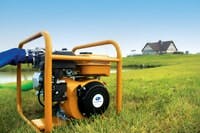Quality pump engines are built to operate for up to 2,500 hours. In a perfect world, those 2,500 hours would be flawless and maintenance free. Equipment always would start on the first pull and never involve tinkering around with seemingly tedious tasks. But because this is not a perfect world, some preventive maintenance is required to avoid the headaches that come from neglecting equipment.
Following recommended maintenance schedules can only increase a pump’s runtime return on investment. Preventive maintenance should be scheduled and performed in a timely manner, even on something as simple as a pump. A little time put into maintenance can do wonders for avoiding downtime and making operation smooth when it comes time to put the pump to work.
Best Practices
Check the fluids. Contaminated oil—or an insufficient amount of it—will cause problems and decrease the life of an engine, so check the quality and level of engine oil daily. Check the gasoline level as well to make sure the tank is full enough for the day’s usage. Also, look for any evidence of leaks. If a fluid is dripping, inspect the area for any parts that may need to be tightened or replaced.
Breathe easy. A clogged, wet, dirty or damaged air filter can allow dirt or water into sensitive areas and lead to a loss in power, shortening the life of an engine. A foam filter can be cleaned and reused, so it is fine to check daily. A paper air filter, on the other hand, always should be replaced upon removal. It is best to follow the owner’s manual when scheduling replacements for either filter.
Remember the hoses. Inspect the condition of the hoses regularly. If they are worn, frayed or have any holes, the air gaps will likely cause the pump to lose suction. Patch any holes, seal leaking joints and replace worn hoses.
Prime time. Running a pump dry will damage the seals and cause a chain reaction of further problems, so remember to add water to prime the pump before starting. The term “self-priming” is somewhat of a misnomer, as water must be added to the pump each time it is used. The pump will then take over, build pressure within the volute and begin discharging.
Spark plugs. Check spark plugs semi-monthly for dirt, damage or excessive carbon buildup. Dirty spark plugs can cause a decrease in power and poor starting performance. Clean spark plugs with a wire brush or spark plug cleaner, and replace any that have cracks in the porcelain.
Fuel strainer. Fuel can become contaminated during operation, and if it is not removed, can lead to trouble with engine starts. Replacing the fuel line and carburetor is expensive, so clean and
inspect the fuel strainer and fuel
filter every month to prevent unnecessary damage. Keep in mind that dusty conditions typically shorten the length of time between regular services, as extreme dust can clog filter elements or contaminate fuel and oil. Depending on
the pump’s environment, maintenance schedules may need to be adjusted to accommodate for
less-than-optimal conditions.
Mark your calendar. On an annual basis, give the pump a thorough inspection for dirty, broken or misaligned parts that can cause problems with the engine or pump components. Inspecting the entire machine gives the most comprehensive view of what needs to be cleaned, replaced and repaired.
Troubleshoot. Even when operators keep up to date with proper preventive maintenance, there can still be problems. When troubleshooting, start with the spark plug. If it is clean and damage free, connect it to the plug cap and ground the plug against the engine body. Pull the starter to see if the spark is weak or nonexistent. If a new plug does not spark, the ignition system is faulty and will need repairs.
The engine also might not start if the spark plug is loose or wet with fuel. If the spark plug is wet, check to see that the fuel cock is closed. If so, close the choke lever and pull the starter handle a half-dozen times to see if the electrode becomes wet. If so, the problem may be that the fuel is stale, in which case it should be drained and refilled with fresh fuel. If the electrode is dry, the problem may be with the fuel intake of the carburetor. Try to see where the fuel stops in the engine.
A number of other things could cause a pump to not self-prime. Start by checking the air on the suction side of the pump and tighten the suction hose or pipe, if necessary. Check the drain plug as well to ensure it has been tightened completely. Remember that insufficient water inside the pump casing also will prevent the pump from priming.
If a pump simply will not run, the culprit is likely the impeller or engine. If the impeller is sticking, disassemble, clean and reinstall it. As for the engine, several different things could prevent it from starting. If the pumping volume has dropped, check the wear on the impeller, make sure the suction hose is not too thin or too long, and tighten any loose parts on the suction chamber. Problems also might be caused by a high suction lift that needs to be lowered, water leaking from the water passage, or a broken mechanical seal.
Prevention is key. Adopting a proactive prevention plan might not make the world perfect, but it is guaranteed to be the least frustrating, least expensive and best way to keep a pump flowing.
Download: Here


